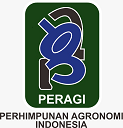Biochar and Azolla Effects on Soil Chemical Properties, Lead Content and Growth of Paddy
Abstract
The objective of the study was to determine the influences of biochar amendments and Azolla sp application on soil chemical value, lead (Pb) content, and growth of paddy. The research was conducted in Growth Centre LLDIKTI I, Medan, Sumatera Utara, Indonesia, from April to July 2014. The research design used a factorial randomized block design with three replications. The first factor was Azolla sp application: without Azolla (A0); Azolla pinnata (A1); Azolla mikropilla (A2)] and the second factor was biochar amendment without biochar (B0); RSB-Rice straw biochar (B1), RHB-Rice husk biochar (B2), CPB-coconut peat biochar (B3), OPB-Oil Palm Empty Bunch biochar (B4)]. The result showed that the biochar amendment treatments had significant differences (P<0.05) in all soil chemical values and growth parameters of paddy. The Azolla application showed significant differences (P<0.05) in plant height, number of tillers, shoot dry weight, root dry weight, and Pb content in the root. The interaction among the Azolla sp and the biochar amendments showed significant differences (P<0.05) in a number of the tillers. It was concluded that the application of rice husk biochar and Azolla microphylla was able to increase soil chemical properties, increase the growth of paddy, and also increase the Pb content in soil, leaves, and roots.
Keywords
Full Text:
PDFReferences
Akhtar, M., Sarwar, N., Ashraf, A., Ejaz, A., Ali, S., & Rizwan, M. (2021). Beneficial role of Azolla sp. in paddy soils and their use as bioremediators in polluted aqueous environments: implications and future perspectives. Archives of Agronomy and Soil Science, 67(9), 1242–1255. https://doi.org/10.1080/03650340.2020.1786885
Alaboudi, K. A., Ahmed, B., & Brodie, G. (2019). Effect of biochar on Pb, Cd and Cr availability and maize growth in artificial contaminated soil. Annals of Agricultural Sciences, 64(1), 95–102.
Asghar, W. (2018). Azolla Bacteria Promoting Rice Growth Under SalineCondition. Agricultural Research & Technology: Open Access Journal, 18(1), 32–34. https://doi.org/10.19080/ARTOAJ.2018.18.556048
Asih, D. W., & Rachmadiarti, F. (2019). Azolla microphylla sebagai Fitoremediator Logam Pb. Lentera Bio : Berkala Ilmiah Biologi, 8(1), 85–90. http://ejournal.unesa.ac.id/index.php/lenterabio
Awodun, M. A. (2008). Effect of Azolla (Azolla species) on physiochemical properties of the soil. World Journal of Agricultural Sciences, 4(2), 157–160.
Chen, Q., Zhang, Z., Wang, Y., Mu, G., Wu, X., Liu, Y., Luo, W., & Wen, X. (2022). Remediation of Soil Contaminated by Heavy Metals Using Biochar: Strategies and Future Prospects. Polish Journal of Environmental Studies, 32(1), 27–40. https://doi.org/10.15244/pjoes/153912
Collin, S., Baskar, A., Geevarghese, D. M., Ali, M. N. V. S., Bahubali, P., Choudhary, R., Lvov, V., Tovar, G. I., Senatov, F., Koppala, S., & Swamiappan, S. (2022). Bioaccumulation of lead (Pb) and its effects in plants: A review. Journal of Hazardous Materials Letters, 3(November), 100064. https://doi.org/10.1016/j.hazl.2022.100064
Cui, L., Li, L., Bian, R., Yan, J., Quan, G., Liu, Y., Ippolito, J. A., & Wang, H. (2020). Short- and Long-Term Biochar Cadmium and Lead Immobilization Mechanisms. Environments, 7(7), 53. https://doi.org/10.3390/environments7070053
El Husieny, A., Hussien, A., Ahmed, B. M., & Elbaalawy, A. M. (2020). Efficiency of Azolla and Biochar Application on Rice (Oryza sativa L.) Productivity in Salt-Affected Soil. Egypt. J. Soil. Sci., 60(3), 277–288.
Huang, X., Zhao, B., Wu, Y., Tan, M., Shen, L., Feng, G., Yang, X., Chen, S., Xiong, Y., Zhang, E., & Zhou, H. (2022). The lead and cadmium content in rice and risk to human health in China: A systematic review and meta-analysis. PLOS ONE, 17(12), e0278686. https://doi.org/10.1371/journal.pone.0278686
Joshi, S., Ramola, S., Singh, B., Anerao, P., & Singh, L. (2022). Waste to Wealth: Types of Raw Materials for Preparation of Biochar and Their Characteristics. In Engineered Biochar (pp. 21–33). Springer Nature Singapore. https://doi.org/10.1007/978-981-19-2488-0_2
Kartika, K., Sakagami, J.-I., Lakitan, B., Yabuta, S., Akagi, I., Widuri, L. I., Siaga, E., Iwanaga, H., & Nurrahma, A. H. I. (2021). Rice husk biochar effects on improving soil properties and root development in rice (Oryza glaberrima Steud.) exposed to drought stress during early reproductive stage. AIMS Agriculture and Food, 6(2), 737–751. https://doi.org/10.3934/agrfood.2021043
Mayly, S., & Hidayat, B. (2015). Effect Of Biochar Amendment On Soil pH and Cec In Pb Polluted Soil. Proceedings of The 5th Annuual International Conference Syiah Kuala University (AIC Unsyiah) 2015 In Conjunction with The 8th International Conference of Chemical Engineering on Science and Applications (ChESA) 2015, September 9-11, 2015.
Mayly, S., Rauf, A., Hanum, C., & Hanum, H. (2019). Rice husk biochar application and the planting times effects on dry weight and water use efficiency of upland rice varieties. IOP Conference Series: Earth and Environmental Science, 260(1), 012132. https://doi.org/10.1088/1755-1315/260/1/012132
Mohamed, M. H. M., Ali, M., Eid, R. S. M., S El-Desouky, H., Petropoulos, S. A., Sami, R., Al-Mushhin, A. A. M., Ismail, K. A., Zewail, R. M. Y., Mahdi, W. M., Al-kurtany, A.-K. A., Hani, A., Hindersah, R., Fitriatin, B. N., Setiawati, M. R., Risanti, R. R., Rahimi, A., Heydarzadeh, S., Ahmadi, F., Yuan, X. (2021). Survey on crop varieties and agricultural practices of Karnataka. Journal of Crop Production, 3(2), 2210.
Muliarta, I. N., & Purba, J. H. (2020). Potential of Loss of Organic Fertilizer in Lowland Rice Farming in Klungkung District, Bali. Agro Bali: Agricultural Journal, 3(2), 179–185. https://doi.org/10.37637/ab.v3i2.567
Naghipour, D., Ashrafi, S. D., Gholamzadeh, M., Taghavi, K., & Naimi-Joubani, M. (2018). Phytoremediation of heavy metals (Ni, Cd, Pb) by Azolla filiculoides from aqueous solution: A dataset. Data in Brief, 21(December), 1409–1414. https://doi.org/10.1016/j.dib.2018.10.111
Safriyani, E., Hasmeda, M., Munandar, Sulaiman, F., Holidi, & Kartika, K. (2020). The role of Azolla on improving nitrogen efficiency in rice cultivation. Iranian Journal of Plant Physiology, 10(2), 3095–3102.
Setyawan, H., Rohmiyati, S. M., & Purba, J. H. (2020). Application of Cow Manure, Urea and NPK Fertilizer Combination on the Growth of Palm Oil (Elaeis Guineensis Jacq) in Pre-Nursery. Agro Bali : Agricultural Journal, 3(1), 74–83. https://doi.org/10.37637/ab.v3i1.419
Subedi, P., & Shrestha, J. (2015). Improving soil fertility through Azolla application in low land rice: A review. Azarian Journal of Agriculture, 2(2), 35–39.
Wang, H., Wang, F., Wang, C., & Han, Y. (2019). Effects of floating Azolla on phosphorus fluxes and recovery from former agricultural lands in wetland microcosms. Soil Science and Plant Nutrition, 65(1), 90–99. https://doi.org/10.1080/00380768.2018.1536387
Zamriyetti, & Mayly, S. (2018). Effect of Rice Hull Biochar Application on Soybean Seed Germination. Proceeding International Conference on Sustainable Agriculture and Natural Resources Management, 249–253. https://jurnal.umsu.ac.id/index.php/ICoSAaNRM/article/view/4316/pdf_41
Refbacks
- There are currently no refbacks.



























